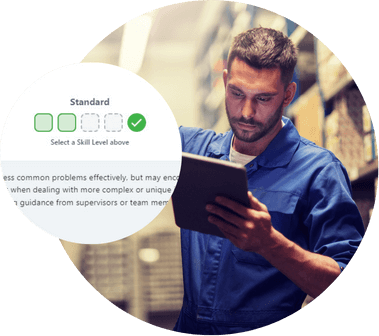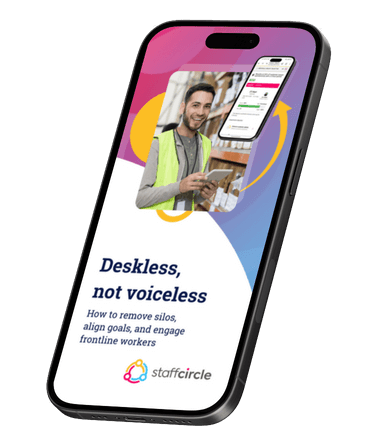
Frontline employees are the backbone of your organization, directly impacting customer satisfaction and operational efficiency.
However, despite their critical role, many frontline workers feel disconnected and undervalued, leading to low engagement and high turnover rates.
To unlock their full potential, it’s essential to engage frontline employees through effective communication, goal alignment, and the right technological tools.
This guide explores the best strategies to engage frontline workers and drive business success, highlighting why frontline employee engagement is important.
Download our free eBook to learn more about how you can engage your frontline workers and transform your business.
Understanding the role of frontline employees
Who are frontline employees?
Frontline employees are the individuals who provide direct, on-site services to clients and customers.
They include various roles such as nurses, retail staff, emergency responders, teachers, and service industry workers. These employees are often the face of your company, interacting with customers and ensuring that operations run smoothly.
Their roles are crucial and complex, often requiring a high level of skill and dedication. Despite their importance, frontline workers frequently operate in isolation from the broader organization, which can lead to feelings of disconnection and disengagement.
Engage your frontline employees effectively by downloading our comprehensive eBook, “Deskless, Not Voiceless”.

The Importance of Frontline Employee Engagement
Engaging frontline employees is not just beneficial; it’s essential for maintaining a productive and motivated workforce. To boost frontline engagement, establish clear communication strategies and utilize digital tools to enhance connection among employees.
Engaged employees are more likely to be satisfied with their jobs, which in turn reduces turnover rates and improves overall performance. When frontline workers feel valued and connected to the company’s goals, they are more motivated to contribute to the organization’s success.
Studies have shown that companies with highly engaged frontline workers experience better customer satisfaction, increased productivity, and stronger financial performance. In a competitive market, engaging your frontline workers can be the key differentiator that drives success.
Challenges Facing Frontline Workers
Common Obstacles to Engagement
Frontline employees face unique challenges that can hinder their engagement and productivity:
- Isolation and Disconnection: Working in dispersed locations or shifts often leads to a sense of isolation among frontline workers. Without regular communication with their peers and management, these employees may feel disconnected from the broader organization.
- Limited Access to Technology: Many frontline employees do not have the same access to modern technology as their office-based colleagues. This tech gap can lead to frustration and inefficiency, further disengaging these vital team members.
- Lack of Growth Opportunities: Frontline roles often come with fewer opportunities for career advancement. Without clear development paths, employees may feel that their efforts go unnoticed, leading to decreased motivation and engagement. Implementing recognition and reward systems can significantly bolster employee morale, ultimately leading to improved retention and job satisfaction.
- Communication Barriers: Effective communication is often a challenge in frontline roles, where employees may lack access to centralized communication platforms. This can result in misunderstandings, missed opportunities, and a general sense of being out of the loop.
Strategies to Engage Frontline Employees
1. Leverage Digital Tools for Communication
Effective communication is the cornerstone to improve frontline employee engagement, especially for frontline workers who may not have regular access to office-based communication channels. Implementing digital tools that allow for real-time communication can bridge the gap between frontline workers and the rest of the organization.
Centralized Communication Platforms: Utilize a centralized communication platform that frontline workers can access from their mobile devices. This platform should include features like company news, updates, training resources, and a feedback loop, ensuring that all employees are informed and engaged.
Example: With StaffCircle’s mobile-friendly communication tools, frontline employees can stay connected, access important updates, and engage with their peers and management, regardless of their location.

2. Align Frontline Goals with Organizational Objectives
For frontline staff to feel engaged, they need to understand how their work contributes to the broader goals of the organization. Clear, aligned goals not only provide direction but also motivate employees by showing them the impact of their efforts.
SMART Goals: Implement the SMART framework (Specific, Measurable, Achievable, Relevant, Time-bound) to set clear and achievable goals for your frontline workers. This approach ensures that each employee understands what they are working towards and how it fits into the company’s overall strategy.
Regular Check-ins: Conduct regular check-ins with frontline workers to review progress, provide feedback, and adjust goals as needed. This ongoing dialogue helps keep employees motivated and aligned with the organization’s objectives.
Example: StaffCircle’s goal-setting tools enable frontline employees to set, track, and achieve goals that align with company objectives, fostering a sense of purpose and engagement.

3. Empower Frontline Employees with Decision-Making Abilities
Empowering frontline workers to make decisions within their roles can significantly boost their engagement. When frontline workers feel trusted to make decisions, they are more likely to take ownership of their work and strive for excellence.
Decision-Making Authority: Encourage managers to delegate decision-making responsibilities to frontline employees where appropriate. This empowerment not only enhances job satisfaction but also improves customer service, as employees can respond more effectively to on-the-ground situations.
Leadership Development: Invest in leadership development programs that prepare frontline workers for decision-making roles. This not only builds their confidence but also ensures that they are equipped to handle the responsibilities that come with increased autonomy.
Example: StaffCircle’s leadership development programs help frontline workers develop the skills they need to make informed decisions, driving engagement and performance.

4. Provide Continuous Feedback and Recognition
Feedback and recognition are powerful tools for engaging frontline workers. Empowering most frontline workers, who are often disengaged due to lack of proper communication and access to necessary tools, is crucial for improving job satisfaction and company performance. Regular feedback helps employees understand their strengths and areas for improvement, while recognition reinforces positive behaviors and achievements.
Continuous Feedback Loops: Establish continuous feedback mechanisms that allow managers and peers to provide real-time feedback. This ongoing dialogue ensures that employees receive the guidance they need to perform at their best.
Recognition Programs: Implement recognition programs that celebrate the achievements of frontline workers. Whether through digital awards, public shout-outs, or tangible rewards, recognizing your employees’ efforts boosts morale and engagement.
Example: StaffCircle’s recognition features enable managers to publicly acknowledge frontline employees’ contributions, fostering a culture of appreciation and motivation.

5. Bridge the Technology Gap
Technology is a crucial enabler of frontline engagement. Providing frontline workers with access to the right tools and technology can streamline their tasks, improve efficiency, and enhance job satisfaction.
Mobile-Friendly Tools: Equip your frontline employees with mobile-friendly tools that integrate seamlessly into their daily routines. These tools should be easy to use and provide access to all necessary resources, from schedules and tasks to company updates and communication channels.
Example: StaffCircle’s mobile app offers intuitive, user-friendly tools that help frontline workers stay connected, efficient, and engaged, regardless of where they are working.

6. Invest in Training and Development
Ongoing training and development are key to keeping frontline workers engaged. By providing opportunities for growth and advancement, you demonstrate that you value your employees and are invested in their success.
https://www.staffcircle.com/blogs/what-is-onboarding/Onboarding Programs: Start with a solid onboarding program that equips frontline workers with the knowledge and skills they need to succeed in their roles. A well-structured onboarding process can reduce stress and improve engagement from the start.
Upskilling and Development: Offer regular upskilling opportunities and manager-in-training programs that help frontline employees advance their careers. This investment in their development not only enhances their skills but also increases loyalty and retention.
Example: StaffCircle’s comprehensive training modules ensure that frontline workers receive continuous development, helping them grow in their roles and stay engaged.

Implementing a Frontline Employee Engagement Strategy
Putting it all Together
Engaging frontline employees requires a comprehensive approach that addresses communication, goal alignment, empowerment, and well-being. By implementing the strategies outlined above, you can create an environment where frontline workers feel valued, motivated, and connected to the company’s success.
Effective Communication: Use a single app to streamline communication with employees, ensuring that frontline teams are always informed and engaged.
Continuous Development: Support the growth of your frontline employees with regular training, feedback, and recognition, fostering a culture of continuous improvement.
How to engage frontline workers: FAQs
How can I effectively engage frontline employees in my organization?
Engaging frontline employees requires a multi-faceted approach that includes clear communication, goal alignment, and access to the right tools and technology. Implementing a centralized communication platform, setting achievable goals, and providing continuous feedback and recognition are key strategies. Empowering frontline workers with decision-making abilities and investing in their professional development also play crucial roles in maintaining high engagement levels.
Want to dive deeper? Download our free eBook to learn proven strategies for engaging your frontline workforce.
What are the benefits of engaging frontline workers?
Engaging frontline workers leads to numerous benefits, including increased productivity, improved customer satisfaction, and reduced turnover rates. When frontline employees feel connected to their organization and valued for their contributions, they are more motivated to perform at their best. This results in better business outcomes, such as higher sales, stronger brand loyalty, and enhanced operational efficiency.
Learn how to unlock these benefits by downloading our free eBook, “Deskless, Not Voiceless”.
What are the challenges of engaging frontline employees?
The right tools are essential for engaging frontline employees. Mobile-friendly communication platforms, performance management software, and digital tools that support real-time feedback and recognition are critical. The good news? StaffCircle’s digital platform makes the top performance and development tools accessible to all employees. These tools ensure that frontline workers are always connected, informed, and able to access the resources they need to succeed in their roles.
Discover how to overcome these challenges with insights from our free eBook. Download it today!
What tools can help in engaging frontline employees?
The first step in effective succession planning is identifying key roles crucial for your business’ success. Our guide provides a detailed template and methodology to assess and rank positions based on priority, consequence, specialisation, and other metrics, enabling you to pinpoint future leaders and high-potential talent.
Download the eBook now!
Why is it important to align goals with frontline employees?
Aligning goals with frontline employees is crucial because it helps them understand how their work contributes to the organization’s success. When employees see the direct impact of their efforts on company goals, they are more likely to stay motivated and engaged. Clear, aligned goals also provide direction and purpose, which are key factors in maintaining high levels of productivity and job satisfaction.
